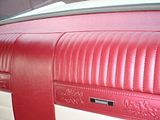I was bashing a recently purchased RMT BANG into a mini Trainmaster-like loco. (It sounds weird but it would looked nice when done, I think). After surgery and insertion of new plastic, filler, etc. I primed it two nights ago with Rustoleum gray auto primer. I've used this primer for years, and had used this particular spray canthe week before, with no problems.
The primer will not complete dry and harden. It HAS dried hard on any new styrene or filler but whereever there is the original painted RMT BANG plastic shell the primer remains, after two days, noticeably sticky to the touch. Its slowly attracting dust out of the air like flypaper.
I know there are paint incompatibilities when painting acrylic over enamel or etc. depending on the thinners used, etc., but I have never had a problem with primer - certainly not this primer. It has been my habit not to strip good paint off models I modify - the risk of doing damage outweighing the benefits in my mind.
I don't know what type of paint is on a BANG, but it does not like this primer. Not sure there is a fix. At this point if I continue the project I will probably just scrap any use of the original body and scratchbuild a new shell.
By the way - this is not the same paint as on BEEPS. I've bashed over a dozen of them , always using this primer, and never a problem.




